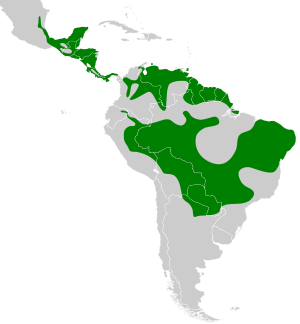Barred antshrike facts for kids
Quick facts for kids Barred antshrike |
|
|---|---|
 |
|
| Male in Goiás, Brazil | |
| Conservation status | |
| Scientific classification | |
| Genus: |
Thamnophilus
|
| Species: |
doliatus
|
 |
|
| Synonyms | |
|
Lanius doliatus Linnaeus, 1764 |
|
The barred antshrike (Thamnophilus doliatus) is a type of passerine bird. It belongs to the antbird family. You can find these birds in a region called the Neotropics. This area stretches from Tamaulipas, Mexico, all the way through Central America and Trinidad and Tobago.
They also live in a big part of South America, east of the Andes mountains. Their range goes as far south as northern Argentina, Bolivia, and Paraguay. There has even been one sighting recorded in southern Texas. These birds live in many different wooded places, including gardens and parks. They can be found in both wet and dry areas. In many parts of their home, they are one of the most common antbirds.
Contents
About the Barred Antshrike's Name
The barred antshrike was first described by a Swedish scientist named Carl Linnaeus in 1764. He gave it the scientific name Lanius doliatus. The name doliatus means "barred" in a old form of Latin.
Scientists later decided that the first place this bird was found was Surinam. There are 12 different types, or subspecies, of the barred antshrike that scientists recognize today.
What Barred Antshrikes Look Like
The barred antshrike is about 15 to 16 centimeters (6 inches) long. It weighs between 24 and 30 grams (about 1 ounce). These birds show clear differences between males and females. This is called sexual dimorphism.
Male Barred Antshrikes
The male bird is covered in black and white bars all over its body. It has a black crest on its head with white at the bottom. The male can raise this crest when it wants to show off.
Female Barred Antshrikes
The female is mostly reddish-brown on her upper body. She has a chestnut-colored crest. The sides of her head and neck have black streaks. Her belly and chest are a rich, yellowish-brown color.
Both male and female barred antshrikes have grey legs. Their beaks are black, and their eyes are a pale yellow color.
Different Subspecies
The different subspecies of barred antshrikes mostly vary in how dark they are. They also differ in how much barring they have and the color of their undersides. For example, the males in Tobago are whiter underneath than other types. The females in Tobago are darker.
The most unique subspecies is T. d. capistratus. This one lives in the Caatinga region of northeastern Brazil. Males of this type have a completely black crown with no white bars. Females have a streaked throat and a slightly barred belly. This is also the only subspecies with deep maroon-red eyes. Some scientists think it should be its own separate species. They call it the Caatinga barred antshrike.
How Barred Antshrikes Behave
Barred antshrikes usually live in pairs and defend their own area. The female lays two creamy white eggs with purple marks. She places them in a deep cup-shaped nest built in a shrub. Both the male and female take turns sitting on the eggs for about 14 days until they hatch. The young birds leave the nest after another 12 to 13 days.
What They Eat
The barred antshrike is an insectivore. This means it mainly eats insects. It finds ants and other small creatures like spiders near the ground. Sometimes, it follows groups of army ants to catch insects that are disturbed. They also eat small lizards and berries.
Their Song
These birds tend to hide in bushes and trees. You might hear them before you see them. They make a chuckling sound like hu-hu-hu-hu-hu-hu. Often, a pair of birds will sing this song together. They also make a growling sound like graaaaa.
Gallery
-
Female, Brazil
-
Male T. d. tobagensis, Tobago
-
Female T. d. tobagensis, Tobago
-
Male, Henri Pittier National Park, Venezuela
See also
 In Spanish: Batará barrado para niños
In Spanish: Batará barrado para niños








